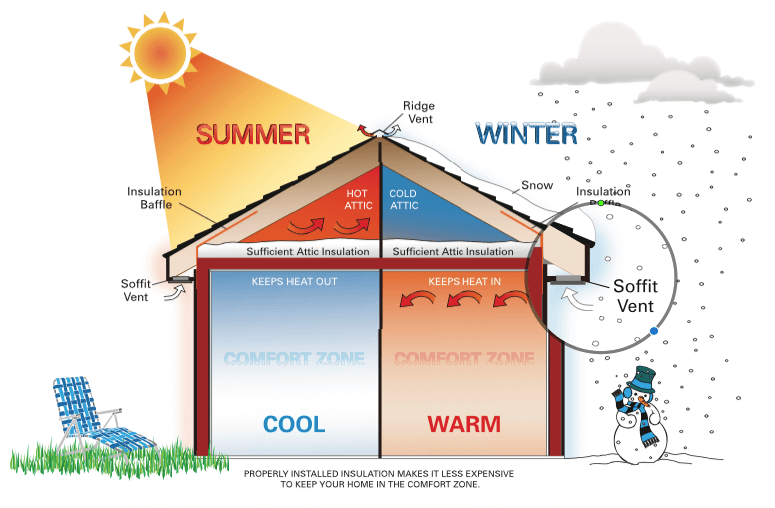
Roof insulation and attic ventilation work in tandem to protect the roof and the home from extremes of heat and cold. The heat of a Madison WI summer can literally bake shingles from the inside out. Free air flow is critical in allowing radiant heat from inside melt snow that can cause ice dams and similar problems. Each element, structural insulation and roof ventilation, provide positive benefits on their own and each contributes to improving energy efficiency and protecting the roof from premature wear.
Roof Insulation and Attic Ventilation Vital in Cold and Heat
As the peak heating season of Madison’s mid-winter approaches, a roof with appropriate insulation is important to help keep the home’s mechanical systems working less and at top efficiency.
A material’s insulating ability is measured by its R-Value. Basically, the higher the R-Value, the greater its insulating effectiveness. It also depends upon the insulation’s construction, thickness and density. Stacking materials can increase the R-Value of the overall installation and its resistance to heat flow.
The amount and type of roof insulation that’s right for your home depends upon the type of heating and cooling system in the house and the architectural design of rooms beneath the roof – cathedral ceilings require a different approach from flat ceilings, etc.
In addition, moisture control is critical to the health and wellbeing of you and your home.
Attic Ventilation Protects Roof Insulation From Moisture
An integral part of an insulation project is installation of a vapor barrier to limit the movement of moisture. Water molecules from inside the home – released through normal activities like showers, baths and doing laundry and dishes – will move through overhead insulation and condense on colder exterior roof sections. When too much condensation occurs on wood and insulation can become saturated. Wet insulation is a very poor insulator and excess moisture leads to mold, mildew and wood rot.
Adding more insulation in the roof area without increasing ventilation at the same time is a formula for serious problems. Depending upon the shape and size of a building’s roof and the extent of the concern, a variety of vent options are available, including:
- Mechanical Attic Vents
- Non-Mechanical Vents
- Ridge Vents
- Gable Vents
- Soffit Vents
- Roof Vents
The Role of Attic Ventilation is Often Misunderstood
Just as most people believe “if some roof insulation is good, a lot is better…” so too, they think that more ventilation is always better. But, do you really want to put more holes in your roof – vents are potential areas for leaks or wind damage. There are options and concerns to consider:
- How much attic ventilation do I really need? A rule of thumb is a 1:300 ratio – meaning one square foot of ventilation for every 300 square feet of ceiling space. The only way to be sure all the factors are considered is to have your overall insulation and related ventilation options evaluated by an experienced roofing professional.
- Ventilation is more important in warmer regions. No way. It’s true that good ventilation will increase energy efficiency in the summer, but preventing moisture damage is a much greater benefit in climates like Madison WI. Are you at risk for moisture damage this winter in your attic insulation? How often does dew collect on the lawn. It can collect inside your house at the same time.
- Do too many vents rob my house of warm air in winter? Because warm air rises, some people think attic vents allow valuable warm air to escape on the winter causing furnaces to work harder. Poor insulation is more of a concern than the air flow. Unless the structure has been built without good insulation and venting, the furnace should not be heating the attic.
- There are vents, so there is “ventilation.” There’s a difference between installing vents and creating proper ventilation. Studies have shown the ridge vents are an excellent form of ventilation but if installed improperly or clogged they provide almost no real ventilation. The same is true for other common vent styles – soffit vents may allow air to be trapped at the peak of the roofline and gable vents can circulate air to a limited area under the roof. One system doesn’t work on every roof with all roof insulation.
Apply A Professional’s Experience
When it’s time to evaluate your home’s roof insulation and attic ventilation, it’s time to tap the skills of the professionals at Sims Exteriors & Remodeling.
Take steps to save energy and improve your indoor comfort. Contact Sims Exteriors and Remodeling at 608-825-4500, or email us to schedule a complete evaluation of the roof insulation and attic ventilation in your Madison WI home.

